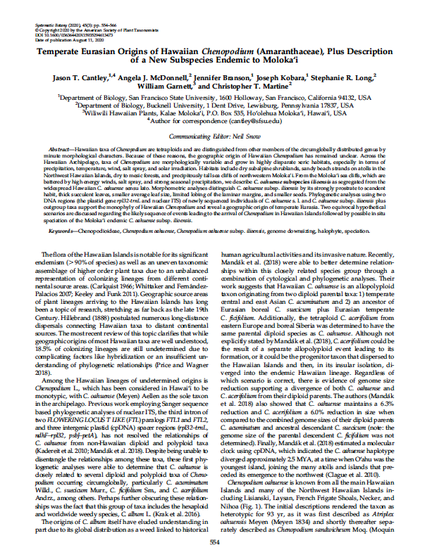
Article
Temperate Eurasian Origins of Hawaiian Chenopodium (Amaranthaceae), Plus Description of a New Subspecies Endemic to Moloka‘i
Systematic Botany
(2020)
Abstract
The morphologically-diverse members of Chenopodium in Hawai‘i are a set of tetraploid taxa distinguished from other members of the circumglobally distributed genus by minute morphological characters. Because of this, the geographic origin of Hawaiian Chenopodium has remained unclear. Across the Hawaiian Archipelago, Chenopodium taxa are morphologically variable and grow in highly disparate xeric habitats—especially in terms of precipitation, temperature, wind, salt spray, and solar irradiation. Habitats include dry subalpine shrublands, sandy beach strand of atolls in the Northwest Hawaiian Islands, dry forests, and precipitously tall sea cliffs of northwestern Moloka‘i. From the Moloka‘i sea cliffs that are battered by high energy winds, salt spray, and strong seasonal precipitation, we describe C. ilioensis J.Cantley & Martine sp. nov. as segregated from the widespread Hawaiian C. oahuense. Morphometric analyses distinguish C. ilioensis through its strongly prostrate to decumbent or scandent habit, thick succulent leaves, smaller average leaf sizes, limited leaf margin lobing, and smaller seeds. Phylogenetic analyses using two DNA regions (the plastid gene rpl32-trnL and nuclear ITS1-5.85 rDNA-ITS2) of newly sequenced C. oahuense and C. ilioensis individuals plus outgroup taxa support monophyly of Hawaiian Chenopodium, show a single colonization of the Hawaiian Islands, and reveal a geographic origin of temperate Eurasia. Two equivocal hypothetical scenarios are discussed regarding the likely sequence of events leading to the arrival of Chenopodium in Hawaiian Islands followed by possible in situ speciation of the Moloka‘i endemic C. ilioensis.
Keywords
- Chenopodiaceae,
- Amaranthaceae,
- Chenopodioideae,
- biogeography,
- Oahu,
- Molokai,
- Hawaii,
- Chenopodium
Disciplines
Publication Date
August 11, 2020
DOI
https://doi.org/10.1600/036364420X15935294613473
Citation Information
Jason T. Cantley, Angela J. McDonnell, Jennifer Branson, Joseph Kobara, et al.. "Temperate Eurasian Origins of Hawaiian Chenopodium (Amaranthaceae), Plus Description of a New Subspecies Endemic to Moloka‘i" Systematic Botany Vol. 45 Iss. 3 (2020) p. 554 - 566 Available at: http://works.bepress.com/christopher-martine/32/
